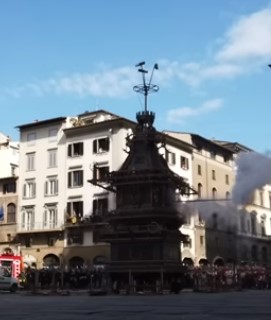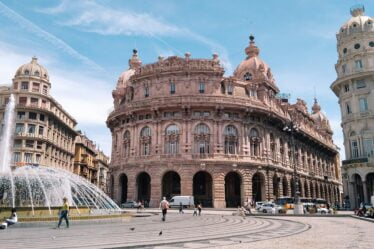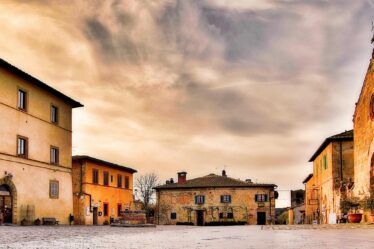
On the morning of Easter day the magic of the “outbreak of the wagon” is renewed. The “Brindellone”, the “fire” chariot escorted by 150 armed, musicians and flag -wavers of the historic procession of the Florentine Republic, moves from the square of the lawn, driven by two pairs of white Bovi Infiorati, and arrives in Piazza del Duomo, where it is placed in the space between the baptistery and the cathedral. Then, at the song of the “Gloria in Excelsis Deo”, fire is set to the fuse of the Colombina who, by hissing, goes to fire the mortgages and fireworks expertly arranged on the cart.
The outbreak of the cart is a ceremony that covers a particular meaning, especially for the Florentines, since it calls into question historical and devotional reasons intimately connected to the identity of the city. Just think of the auspices taken for centuries from the flight of the Colombine which from the main altar of the Cathedral reaches the chariot causing its outbreak; From the trend of that race it has always fantasized on how the imminent crop season would have presented in the countryside. Not to mention the legendary history of the toast: the word “Brindellone” belongs to the Florentine jargon and defines a high, dictated person, perhaps a little bad and a little beggar, which you look with a certain as affection and with one substantial sympathy. It seems that the origin of the combination between this word and the chariot goes up to the feast celebrated by the Florentine mint in honor of its protector, San Giovanni Battista.
On June 24 a chariot of hay started from the tower of the mint and went around the city, driving a man dressed in rags that obviously represented the Hermit Holy and who was called “Brindellone”, also because he tended to dictate a lot, especially after eating and drunk abundantly during the banquet consumed in the square. Since then the term remained in popular use to identify all the wagons used in the city for public ceremonies. This party dates back to the distant days of the first crusade and, in particular, on the return from Jerusalem of the Florentine captain Pazzino dei Pazzi who brings with him three stone flakes of the Holy Sepulcher. The three stones were used to draw a “new” spark of fire distributed to the Florentine families, after the blessing, to rekindle the domestic hearth.
In this way, the use of distributing the “Holy Fire” as a sign of resurrection to the clergy and people. It was the Pazzi family, in fact, with the construction of the monumental “chariot”, who laid the foundations of today’s ceremony which, in a manner Symbolic, distributed the blessed fire to the whole city. Starting from the seventeenth century, the ceremony assumed the current characteristics, with four gracefully dressed oxen that tows the Brindellone from the headquarters of the Prato to the Cathedral.
If you like this story of a unique tradition of Florence, and you like to discover more about our City, you could come to visit our town and take a tour with us. We are running a Florence free walking tour, from Santa Maria Novella square. Our meeting point is in front of Minerva Hotel. please book your tour before you show up.



